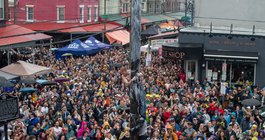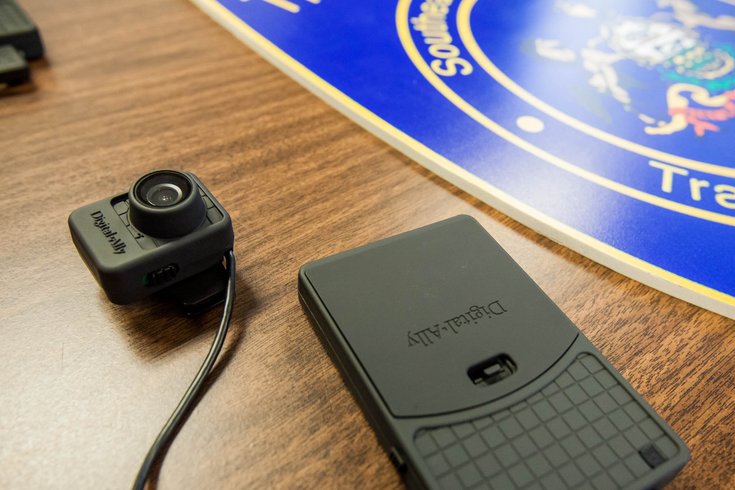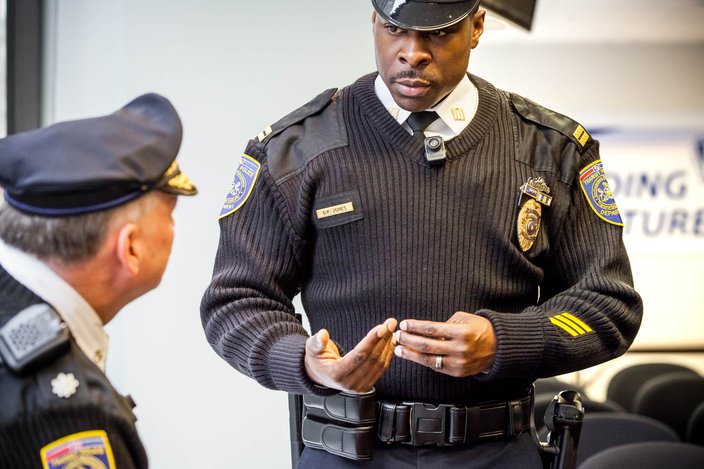
January 08, 2016
 Thom Carroll/PhillyVoice
Thom Carroll/PhillyVoice
SEPTA transit police will use the Digital-Ally body cameras, shown above at the SEPTA Transit Police headquarters on Friday, Jan. 8, 2016.
All SEPTA Transit Police began wearing body cameras at the beginning of the year, a step Chief Thomas Nestel says will ensure that the public's constitutional rights are upheld while also protecting officers from false claims of abuse.
"This is going to be very good for the public and for the police," Nestel said during a press conference Friday morning. "Cameras are going to make good cops great cops and make the rest of them follow the rules."
The $400,000 program, approved by the SEPTA Board in July, equips all 289 SEPTA Transit officers with Digital Ally First VU body cameras. The decision to equip the officers was made following a pilot program in which 15 officers tested cameras from 10 different vendors. The pilot program began in July 2014.
SEPTA officers will be required to activate the cameras when interacting with the public or responding to police radio calls. Officers must turn on their cameras when interactions move beyond pleasantries and casual conversations. They also must notify the public that the camera is recording.
"The benefit of the cameras span a wide spectrum," Nestel said. "We're going to be ensuring that constitutional rights are guaranteed. We're going to be ensuring the professionalism and respect is delivered to the public. But we're also going to be protecting officers from false complaints and retaliatory actions by persons that have been arrested."
All videos will be archived for 90 days. Videos that show investigative or evidentiary material will be kept until the end of the investigation.
When officers conclude their shift, videos will be uploaded to a server that only police administrators can access.
SEPTA officers will be subject to random compliance checks. Officers who fail to turn on their cameras will face penalties relative to the severity of the violation.
"It's going to depend on the officer's past behavior with the camera," Nestel said. "If we look at that officer's video clips for days prior and find that he or she is not activating their camera at all, that's a pretty serious problem."
 Thom Carroll/PhillyVoice
Thom Carroll/PhillyVoiceSEPTA Transit Police Special Operations Captain, Daryl K. Jones, right, is shown wearing a newly-implemented body camera, Friday, January 8, 2016.
To demonstrate the varied benefits of the cameras, Nestel played three videos recorded by SEPTA officers during the pilot program.
One video revealed a handcuffed man yelling and banging his head against a police car. Nestel said a citizen filed a complaint alleging a SEPTA officer used excessive force in the incident. The video revealed otherwise, clearing the officer, Nestel said.
"These cameras are going to be huge in investigating the validity of those complaints," Nestel said. "I'm not saying that the public is falsely accusing the police. I'm saying that the perception sometimes is wrong."
Another video showed an officer investigating a panhandling complaint. As the officer and the alleged panhandler exit the elevated train, screams are heard in the distance. A woman then runs down the station platform, but halts and holds up her hands when she sees the officer.
"That person snatched a phone on the train," Nestel said. "She thinks she's caught, but she's not – because the officer still has no idea what's going on. That suspect goes past and down the steps of the station.
"The officer heads toward the scream and finds out that person had just stolen a phone. We were able to put out that image right away to officers in the field and an arrest was subsequently made. Great evidence for court."
The third video revealed an inebriated man spitting on a police officer as he was loaded into a holding vehicle.
All officers have been trained on the body cameras, Nestel said. But he said getting both his officers and the public comfortable with the program will be a process.
"It's a massaging of the facts," Nestel said. "It's showing both the public and the police that this type of technology can be very useful for everyone."